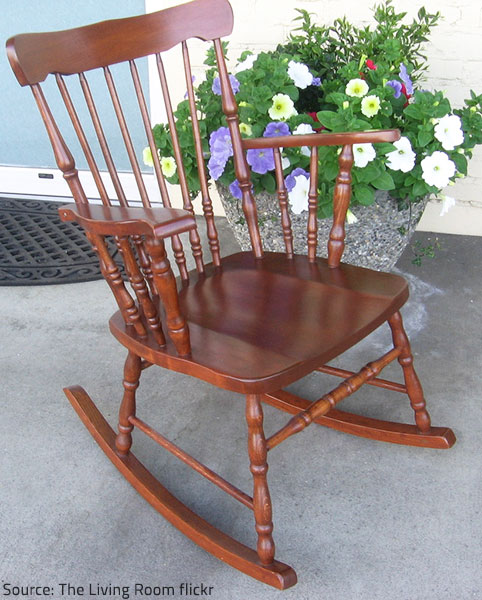
Old wooden pieces add unique charm and beauty to your home decor.
Without a doubt, most (if not all) of the items in your home have a certain amount of practical, aesthetic, or sentimental value. It is only logical, of course, as you wouldn’t keep an object unless you find it very useful, or quite charming, or fondly reminiscent of someone or something special. After many years of daily use, however, all your cherished possessions inevitably start looking old and tired. So, if you don’t want to replace them for new ones (because of financial, emotional or practical reasons), you need to come up with an efficient way to restore your worn-out items to a beautiful and serviceable condition. More often than not, there will be some quite affordable and effective methods to do so. Just make sure you research your options and find the one that will work best for your particular needs.
If it is your old wooden furniture that needs rejuvenating (as is most often the case), you can choose from three possible solutions:
1) Preservation – if your furniture shows some signs of wear and tear but is still in good overall condition, your best option is to preserve its original finish, structure and design. Cleaning and waxing will probably be enough to remove any surface dirt, grime, and minor blemishes and reveal the beauty of the wood;
2) Restoration – when your piece is mostly intact but looks worn out and tired, some subtle touch-ups (including skillful repair of broken pieces, veneers and carvings) can restore its original gorgeous looks and sturdy feel. This time-consuming and highly demanding process, however, is typically reserved for quality antiques or family heirlooms with high monetary or sentimental value;
3) Refinishing – battered furniture pieces usually need to be refinished in order to become serviceable and aesthetically pleasing once again. Refinishing involves stripping away the existing finish, preparing the bare wood, staining the piece (if desired), and applying new finish.
But how to understand which of these options is most appropriate for your own worn-out furniture?
Factors to Consider when Dealing with Old Furniture
Should you restore or refinish your old furniture? In order to make the right decision, you need to take into account several important issues:
1. What is the real value of your furniture piece?
If your worn out furniture piece is a rare antique or an artistic masterpiece, you should be very careful not to reduce its great value. So, before you decide on refinishing your old dresser, or armoire, or dining table, etc., find out if it is:

Whether it is a treasured family heirloom or not, antique furniture has great commercial and artistic value.
- An antique – all furniture pieces made more than 100 years ago have great market value;
- Finished with a hand-painting technique – intact hand-painted finishes add considerable value to a furniture piece;
- Made by a notable craftsman or manufacturer – look for any marks or labels that may indicate your furniture’s origin. Exquisite pieces made by famous artisans can cost a fortune.
In all of the above cases, refinishing your worn-out piece may actually reduce its value, regardless of how beautiful it turns out in the end. Have in mind that the natural wear and the original finish on antique and vintage furniture make it more valuable. So, you are strongly advised to have such precious pieces carefully cleaned and professionally restored (if necessary) in order to preserve their excellent condition and high value.
2. Is your furniture invested with sentimental value?
Regardless of whether your old furniture is a masterpiece of art or not, it may have very high sentimental value. If so, its monetary value may be completely irrelevant, as the piece in question will never be sold or even appraised. You will most likely need it to be usable, to look beautiful, and to match your home décor. Furniture refinishing is definitely your best option under such circumstances.
3. What are your intentions?
The most appropriate way to rejuvenate your old furniture depends primarily on your plans:
- If you intend to sell the piece, you’ll certainly want to make the most out of it. So, if it is an antique, it should be carefully restored without affecting the patina, texture and appearance of the old wood, as those elements are very valuable and impossible to recover. If it is a newer piece, have it properly repaired and refinished, so that it looks fashionable, stylish, and impressive;

When properly restored, old furniture can be not only aesthetically pleasing but also quite practical.
- If you intend to use the piece in your current home design, you’ll need it to be as practical as possible. An experienced professional can refinish old furniture for a fraction of the cost of a new item of similar quality. Besides, you are going to get a much better-built piece of furniture, constructed with better wood, and painted in whatever tones you’d like in order to match the color scheme of your interior décor;
- If you want to preserve a family heirloom, you’ll want to stabilize the piece and to keep its finish and surface features intact. Use the least invasive method possible for improving the condition of your furniture (a good cleaning and minor repairs) and take adequate measures to protect it from potential damage (direct sunlight, high moisture levels, chewing, scratching, etc.).
4. What is the condition of the existing finish?
The extent of the damage will make it clear if your old furniture needs refinishing, restoring, or just some careful cleaning:
- If the finish is coming off in flakes, if it is cracked or sticky (even after cleaning), if it has large unsightly blemishes or the wood beneath it has dark patches or rings, then you should have your furniture refinished;
- If the finish appears dull and lifeless, if it is worn out and has minor scratches or nicks, but no major blemishes, then professional furniture restoration will yield the best results;
- If the finish looks dirty and tired, but is otherwise intact, cleaning and waxing will be enough to restore its original beauty.
5. Is it worth the cost?

It’s up to you to find the right balance.
Even if it is not a valuable antique or a family heirloom, old furniture is usually worth preserving because of its fine workmanship and high quality material (have in mind that modern pieces are rarely made of the high quality wood that was used in the past and as exquisitely crafted as some 50 years ago). Besides, professional refinishing will cost you about one third of the market price of a new piece and will allow you to refresh your interior design without replacing your cherished wooden pieces that perfectly fit your home layout. Restoring an existing finish can sometimes be even less expensive than refinishing (depending on the complexity of the work).
However, you need to assess your actual needs and preferences, as well as the benefits you will get, before undertaking the project. Other relevant factors, such as the time and the efforts required to finish the work, should also be taken into account.
Also, keep in mind that although it may be the cheaper option, trying to refinish or restore delicate or antique furniture pieces yourself is not a good idea, as you may easily ruin them.
Finally, here are a few more essential things to remember in order to avoid rookie mistakes when it comes to breathing new life to your worn-out furniture.
Tips for Restoring Old Furniture
All things considered, the decision to restore or refinish furniture comes down to a personal preference. So, to make the ultimate judgment, you are advised to:
1) Have your old furniture evaluated first – especially if you are not sure of the actual value of your pieces, you should have them professionally appraised before making a final a decision. Removing a collectible antique’s finish will undoubtedly lessen or void its value, so you need to be very careful and hold off any refinishing procedures until you know exactly what you have. Inspect your piece, make a thorough research, and seek the advice of antique restoration specialists in your area to avoid ruining your valuable furniture;

What matters the most is your old furniture to turn out serviceable and beautiful in the end.
2) Try cleaning and dusting your worn out furniture before taking more extreme measures – a thorough cleaning and some subtle touch-ups may be enough to restore the excellent condition of your piece. So, why waste time, money and nerves on more complicated projects that may even decrease your furniture’s value?
3) Use the least invasive renewal method possible – even if your old furniture is not particularly valuable, it’s always better to restore it to its original state if possible. The original finish and the natural patina of a piece have their own unique charm and enhance the overall appeal of your home décor;
4) Leave the restoration of a valuable piece to a skillful professional who has extensive experience with delicate furniture. The specialist will not only preserve the market value of your antique but will even enhance its worth. And you will be delighted by the astonishing results!












